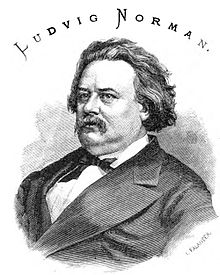Ludvig Norman

Ludvig Norman(28 August 1831 – 28 March 1885) was aSwedishcomposer,conductor,pianist,and music teacher. Together withFranz BerwaldandAdolf Fredrik Lindblad,he ranks among the most important Swedishsymphonistsof the 19th century.
Norman was bornFredrik Vilhelm Ludvig NormaninStockholm.[1]
Norman began his musical training with Lindblad and later studied at theLeipzig Conservatoryfrom 1848 to 1852, where he also made the acquaintance ofRobert Schumann.Starting in 1857, he taught at theRoyal Music Academy of Stockholm.In 1860, he became the conductor of the Nya harmoniska sällskapet and obtained the post of Kapellmeister at theRoyal Swedish Operathe following year. After 1881, he conducted the choral concerts of the Musikvorenigen. He was married to the noted violinistWilma Nerudain 1864. Their son Ludwig Norman Neruda was a famousalpinist.
As conductor, he is remembered for premieringFranz Berwald'sfourth symphonyon 9 April 1878.[2][3]
Norman composed in a wide variety of genres, including four symphonies, fourovertures,four sets ofincidental musicfor plays,cantatas,andchamber music,as well as a great number ofliederand songs forchoir.
He was the dedicatee ofWoldemar Bargiel's octet for strings.[4]
His pupils includedElfrida Andrée.[5]
Ludvig Norman died in 1885 in Stockholm.[1]
Selected works
[edit]Orchestra
- Symphony No. 1 in F Major, Op. 22 (1857)
- Symphony No. 2 in E♭Major, Op. 40 (1871)
- Symphony No. 3 in D Minor, Op. 58 (1881)
- Concert Overture in E♭Major, Op. 21 (1856)
- Funeral March, 'To the Memory of August Söderman', Op. 46 (1876)
- Overture to Shakespeare'sAntony and Cleopatra,Op. 57 (1881)
- Festive Overture in C Major, Op. 60 (1882)
- Concertstück for Piano and Orchestra, Op. 54 (rev.1880)
Chamber music
- Piano Trio No. 1 in D, Op. 4 (1849, pub. 1853)[6]
- Piano Trio No. 2 in B minor, Op. 38[7]
- "5 Tonbilder im Zusammenhange" for violin and piano, Op.6 (1851, publ 1854)
- Sonata for Violin and Piano in D minor, Op. 3 (1848, pub. 1852)[6]
- Piano Quartet in E Minor, Op. 10
- String Sextet in A major, Op. 18
- Sextet for Piano and Strings in A minor, Op. 29
- Sonata in G Minor for Viola and Piano, Op. 32
- String Octet in C Major, Op. 30
- Sonata in D Major for Cello and Piano, Op. 28
- String Quartet No. 1 in E♭Major (1848)
- String Quartet No. 2 in E Major, Op. 20 (1855)(published 1882)[8]
- String Quartet No. 4 in D Minor, Op. 24[9](1858)
- String Quartet No. 5(?) in C Major, Op. 41/42 (begun 1871, finished 1883)[10]
- String Quartet No. 6 in A Minor, Op. 65 (1884, pub. 1887)[6][11]
- String Quintet in C Minor, Op. 35
References
[edit]- ^ab"MusicSack".RetrievedOctober 5,2011.
- ^Woodstra, Chris; Brennan, Gerald; Schrott, Allen (2005).All Music Guide to Classical Music: The Definitive Guide to Classical MusicatGoogle Books.CMP Media. page 158.ISBN0-87930-865-6.
- ^Norman is described as Berwald's greatest advocate during his (Berwald's) lifetime and in the years after his death by Frederick Key Smith (2002) inNordic Art Music: From the Middle Ages to the Third MillenniumatGoogle Books.Greenwood Publishing Group. page 36.ISBN0-275-97399-9.
- ^"Notes to Recording of Bargiel and Mendelssohn Octets".Hyperion Records. 1989.Retrieved2008-05-11.
- ^Sadie, Julie Anne; Samuel, Rhian (1995).The Norton/Grove Dictionary of Women ComposersatGoogle Books.W.W. Norton & Company. p. 16.ISBN0-393-03487-9.
- ^abcHofmeisters Monatsbericht
- ^SeeOCLC611070938
- ^Hofmeisters Monatsberichte, August 1882, p.212.
- ^"Swedish Musical Heritage, Detailed Information on Norman Quartet No.4"(in Swedish).RetrievedMay 1,2013.
- ^"Swedish Musical Heritage- Detailed Information on Norman Quartet in C major (no number given)".RetrievedMay 1,2013.
- ^"Swedish Musical Heritage, Detailed Information on Norman Quartet No.6 in A minor"(in Swedish).RetrievedMay 1,2013.
External links
[edit]- 1831 births
- 1885 deaths
- 19th-century classical composers
- 19th-century conductors (music)
- 19th-century classical pianists
- 19th-century Swedish people
- Swedish male classical pianists
- Swedish male conductors (music)
- Musicians from Stockholm
- Romantic composers
- Academic staff of the Royal College of Music, Stockholm
- Swedish classical composers
- Swedish conductors (music)
- Swedish classical pianists
- Swedish male classical composers
- University of Music and Theatre Leipzig alumni
- String quartet composers
